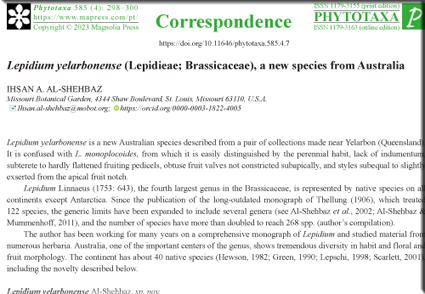Abstract
Lepidium yelarbonense is a new Australian species described from a pair of collections made near Yelarbon (Queensland). It is confused with L. monoplocoides, from which it is easily distinguished by the perennial habit, lack of indumentum, subterete to hardly flattened fruiting pedicels, obtuse fruit valves not constricted subapically, and styles subequal to slightly exserted from the apical fruit notch.
References
Al-Shehbaz, I.A. & Mummenhoff, K. (2011) Stubendorffia and Winklera belong to the expanded Lepidium (Brassicaceae). Edinburgh Journal of Botany 68: 165–171. https://doi.org/10.1017/S0960428611000060
Al-Shehbaz, I.A., Mummenhoff, K. & Appel, O. (2002) Cardaria, Coronopus and Stroganowia are united with Lepidium (Brassicaceae). Novon 12: 5–11. https://doi.org/10.2307/3393229
Green, P.S. (1990) Notes relating to the floras of Norfolk and Lord Howe Islands, III. Kew Bulletin 45: 235–255. https://doi.org/10.2307/4115682
Hewson, H.J. (1982) The genus Lepidium L. (Brassicaceae) in Australia. Brunonia 4: 217–308. https://doi.org/10.1071/BRU9810217
Linnaeus, C. (1753) Species plantarum. L. Salvius, Holmiae [Stockholm], 1200 pp.
Lepschi, B.J. (1998) Notes on the genus Lepidium (Brassicaceae) in Western Australia, including recognition of a new species, L. amelum. Nuytsia 12: 191–195.
Mueller, F.J.H.von (1855) Definitions of rare or hitherto undescribed Australian plants, chiefly collected within the boundaries of the Colony of Victoria and examined by Dr. Ferd. Mueller. Transactions of the Philosophical Society of Victoria 1: 34–50.
Scarlett, N.H. (2001) Lepidium ginninderrense (Brassicaceae), a new species from the Australian Capital Territory. Muelleria 15: 69–74. https://doi.org/10.5962/p.237632
Thellung, A. (1906) Die Gattung Lepidium (L.) R.Br. Eine monographische Studie. Neue Denkschriften der Schweizerischen Naturforschenden Gesellschaft 41 (1): 1–340. https://doi.org/10.5962/bhl.title.15476
Al-Shehbaz, I.A., Mummenhoff, K. & Appel, O. (2002) Cardaria, Coronopus and Stroganowia are united with Lepidium (Brassicaceae). Novon 12: 5–11. https://doi.org/10.2307/3393229
Green, P.S. (1990) Notes relating to the floras of Norfolk and Lord Howe Islands, III. Kew Bulletin 45: 235–255. https://doi.org/10.2307/4115682
Hewson, H.J. (1982) The genus Lepidium L. (Brassicaceae) in Australia. Brunonia 4: 217–308. https://doi.org/10.1071/BRU9810217
Linnaeus, C. (1753) Species plantarum. L. Salvius, Holmiae [Stockholm], 1200 pp.
Lepschi, B.J. (1998) Notes on the genus Lepidium (Brassicaceae) in Western Australia, including recognition of a new species, L. amelum. Nuytsia 12: 191–195.
Mueller, F.J.H.von (1855) Definitions of rare or hitherto undescribed Australian plants, chiefly collected within the boundaries of the Colony of Victoria and examined by Dr. Ferd. Mueller. Transactions of the Philosophical Society of Victoria 1: 34–50.
Scarlett, N.H. (2001) Lepidium ginninderrense (Brassicaceae), a new species from the Australian Capital Territory. Muelleria 15: 69–74. https://doi.org/10.5962/p.237632
Thellung, A. (1906) Die Gattung Lepidium (L.) R.Br. Eine monographische Studie. Neue Denkschriften der Schweizerischen Naturforschenden Gesellschaft 41 (1): 1–340. https://doi.org/10.5962/bhl.title.15476


